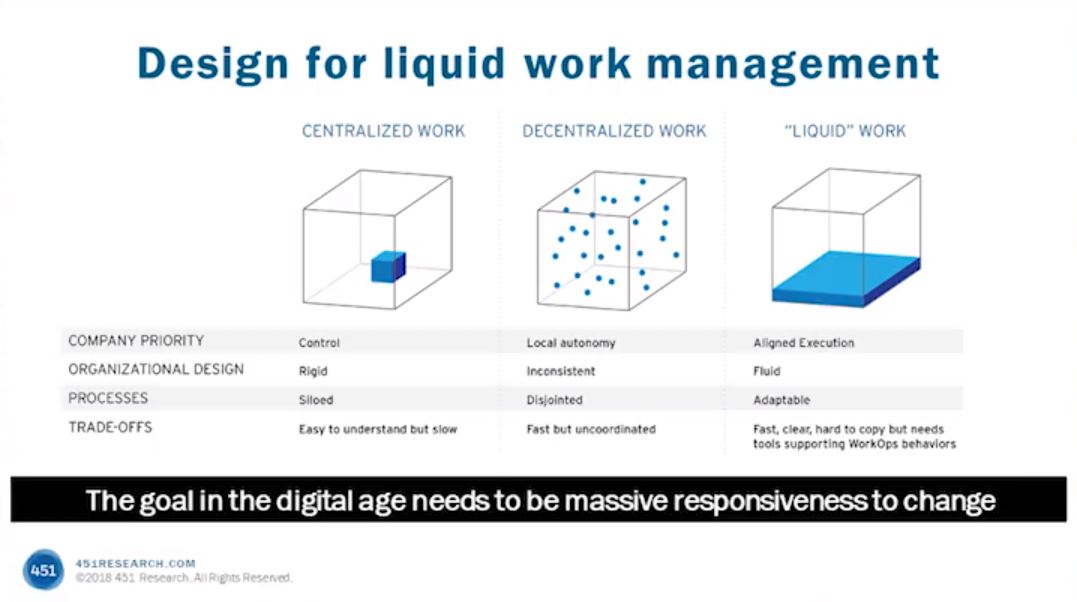
With its Horizons conference in October, Planview pulled together a large cohort of its customers for two days to discuss the challenges and goals ahead for project management professionals and their organizations. During the event, I had the opportunity during one of the keynotes to present some of the views of 451 Research on how to embrace change and keep the PMO relevant. If you missed the presentation or wish to see it again, click this link to watch the full video.
It’s time to become a ‘liquid’ enterprise.
The key challenge in work execution that companies face is how to move beyond information, people, and data silos that have given rise to pervasive technology and productivity friction in an effort to become more responsive to new market and user requirements driven by digitization. That friction for almost all organizations substantially weakens work execution and creates what we call strategic debt—the differential between needing to change and being able to do so.
To move beyond these challenges, the goal, in our view, should be to become what we call ‘liquid’. To invest in those technologies and work practices that allow you to highly-responsively tesselate, not only your different human, digital, and physical resources, but also your actual corporate design.
The ‘liquid enterprise’ is the end-state we see the next generation of digital native businesses building towards. It gives the basis on which to execute effectively as the overall speed of work execution increases, where more work will be open-ended, with less work having a finite beginning and end, and where the design and execution of work needs to become more flexible and contextually intelligent.

Inevitably, how to get there is going to be multi-faceted. First of all, you must realize this predicament and get ahead of the change, realize the need to design your work constructs in a way that mitigates existing silos, allows for scale, allows for everything to be reportable, gives you the ability to model your work scenarios, deeply engages your employees by empowering them with more agency, and provides transparency across your organization around goals, execution, and contributions. Not doing any one of these will open you to challenging friction in your work planning, execution, and tracking.
More specifically, realize that with a growing application estate continuing to be catalyzed by SaaS, more work is going to need to happen across apps facilitated by custom workflows.
Ensure flexibility with the tools you’re using.
Look to the tooling that gives you the ability to create new work constructs, leveraging extensive connectivity across the different nodes of work. Look to make collaboration more interstitial within the context of structured work rather than a separate location not connected to it.
Think about how you can decentralize ownership over the design and management of work, including complex work scenarios, business divisions, teams and individuals, and those closest to where work is being delivered.
Begin to think about how to enable more of what we term ‘WorkOps’ practices, where highly responsive work execution is enabled by having intelligent context, workflow automation, collaboration, and reporting embedded across the lifecycle. Where localized teams are empowered with the freedom to design and create new work processes at the local level that will unlock new ways of organizing resources across the company. And where individuals can self-organize into both temporary and permanent workstreams. This kind of flexibility as nodes, including people, tessellates much more easily to execute work we believe will be a key characteristic of enterprises’ future digital competitiveness.
Adopt WorkOps practices to become more responsive.
For the PMO and project management professionals, this new manifesto for modern work execution has a number of implications. First and foremost, it entails rethinking “projects” and “portfolios.” Less work will be strictly sequential, objectives and requirements increasingly conceived outside of a finite start and end lifecycle. Unlike traditional PMO-centric work, WorkOps also places growing emphasis on tooling the decentralization of work everyone essentially becomes a project manager. Rather than finite projects, more work scenarios will be operationalized, with visibility and learnings across the lifecycle feeding continuous execution of what becomes essentially ongoing, repeating and dovetailing work streams. These work streams will lubricate the liquid enterprise’s high responsiveness to changing market and user requirements.
Like Lean and Agile methodologies, WorkOps also puts the focus on continuously learning to optimize a system of delivery, those doing work are best placed to decide how it is done, and the focus is on responding quickly to changes rather than seeing out an agreed-upon plan. It treats all the nodes across an organization physical, digital and human as though they were each programmable; the goal to infuse as much intelligence and automation around those nodes as possible.
What this shift implies is a much more delicate balance for the PMO between centralization and localization. Ensuring standard definition, documentation, and delivery of work and the generalizing of best practices with more latitude for variable work environments, resources and requirements; the need for much more rapid decision-making, prioritizing the flow of work and enabling a high degree of specialization in local execution. It needs an even clearer line of sight from strategy to outcomes, it requires work to be data-driven to its core and relies on wide transparency.
For the modern project manager, the skill set needs to evolve. The ability to design for and generate insights across work streams and synthesize work management best practices from diverse types of work scenario. There needs to be a heavier emphasis on communication, negotiation, influencing, and stakeholder management skills. It also requires technical understanding, if not specialism, in these new work arteries shaping the future of work.
This is an evolution, not a revolution. There is still a huge need within enterprises for specialist skills around the design, management, and reporting of work. If it plays its cards right, the PMO will evolve to become a strategic organizational asset in the future digital native businesses that will win.



![Collectively Deliver on Strategy with Digital Transformation [Video]](https://blog.planview.com/wp-content/uploads/2018/07/Collectively-Deliver-on-Strategy-with-Digital-Transformation-2.jpg)
![Project Management Software: Chaotic Ways of Working [Video]](https://blog.planview.com/wp-content/uploads/2017/08/Chaotic-Ways-of-Working-2.jpg)


